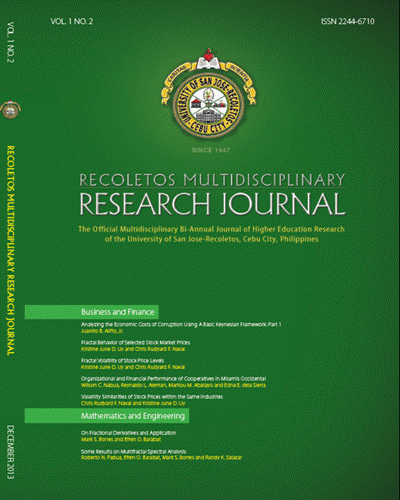Analyzing the Economic Costs of Corruption Using a Basic Keynesian Framework: Part 1
DOI:
https://doi.org/10.32871/rmrj1301.02.01Keywords:
corruption, corruption perception index, Keynesian framework, investment multiplier, government multiplierAbstract
This study attempts to analyze the impact of corruption on the economy by adopting the Keynesian Framework. Current studies show that corruption has adverse effects on GDP, GDP growth rate, and investment, among others. Such studies, however, used the “economic cost-corruption perception index†model. An alternative model is to adopt a Keynesian framework incorporating corruption as a factor in the model. Utilizing the concepts of investment and government multipliers, the comparative analysis between the “withâ€-and-“without†corruption is used in analyzing the economic cost of corruption. The results show that government multiplier is less than the investment multiplier when there is corruption. Based on the theses/arguments, this study concludes that (a) when
there is corruption, the impact of government expenditure on the economy is less than the impact of investment expenditure on the economy, (b) the Keynesian model can enhance the explanatory power of the existing “economic cost-corruption perception index†model of analyzing the economic cost of corruption, and (c) the results of integrating corruption into the Keynesian model reveal that GDP and GDP growth rate are overestimated for countries with a certain proportion of government expenditure that go to corruption.
References
Ackley, G. (1978). Macroeconomics: Theory and Policy. London: Collier Macmillan Publishers.
Blanchard, O. (2003). Macroeconomics, 3rd ed. Upper Saddle River, New Jersey: Prentice Hall.
Frank, R. H., and Bernanke, B. S. (2001). Principles of Macroeconomics. Boston: McGraw-Hill/Irwin.
Henderson, J. M. and Quandt, R. T. (1980). Microeconomic Theory: A Mathematical Approach, 3rd ed. New York: McGraw-Hill Book Company.
Keynes, J. M. (1964). The General Theory of Employment, Interest, and Money. New York: Harcourt, Brace, and World.
Klitgaard, R. (1988). Controlling Corruption. Berkeley, CA: University of California Press.
Krueger, A. (1974). The Political Economy of the Rent- Seeking Society. AMERICAN ECONOMIC REVIEW. Vol. 64, No. 3: 291-303.
LaPalombara, J. (1994). Structural and Institutional Aspects of Corruption. SOCIAL RESEARCH. Vol. 61: 325-350.
Mankiw, N. G. (2003). Macroeconomics, 5th ed. New York: Worth Publishers.
Mauro, P. (1995). Corruption and Growth. QUARTERLY JOURNAL OF ECONOMICS, 110(August): 681-712.
Mauro, P. (1997). The Effects of Corruption on Growth, Investment, and Government Expenditure: A Cross-Country Analysis. In Elliott, K. A. (ed.) CORRUPTION AND THE GLOBAL ECONOMY. Washington, DC: Institute for International Economics: 83-107.
Murphy, K. M., Shleifer, A., and Vishny, R. W. (1991). Why is Rent-Seeking So Costly to Growth? AMERICAN ECONOMIC REVIEW, 83 (May): 409-414.
Pellegrini, L. and Gerlagh, R. (2004). Corruption’s Effect on Growth and its Transmission Channels. KYKLOS, Vol. 57, Fasc. 3, 429-456.
Rock, M.T., and Bonnett, H. (2004). The Comparative Politics of Corruption: Accounting for the East Asian Paradox in Empirical Studies of Corruption, Growth, and Investment. WORLD DEVELOPMENT, Vol. 32, No. 6: 999-1017.
Samuelson, P. A., and Nordhaus, W. D. (2005). Economics, 18th ed. Boston: McGraw-Hill/Irwin.
Wei, S-J in. (2000). Does Corruption Relieve Foreign Investors of the Burden of Taxes and Capital Controls? In Hines, J. R. (ed.). International Taxation and Multinational Activity. University of Chicago Press.
Downloads
Published
How to Cite
Issue
Section
License
Copyright of the Journal belongs to the University of San Jose-Recoletos


